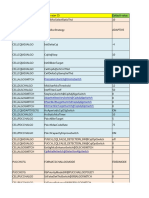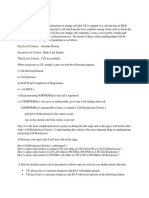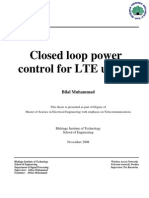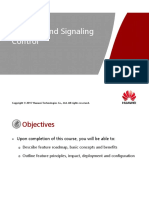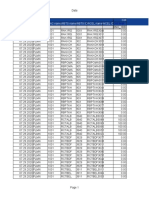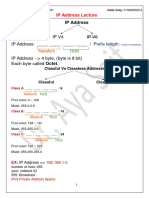0 ratings0% found this document useful (0 votes)
108 viewsDRX Set 1 On SHJ Sites - LTE KPI Report - 21072013
DRX Set 1 On SHJ Sites - LTE KPI Report - 21072013
Uploaded by
Aqeel HasanThe document reports on key performance indicators for LTE networks before and after the implementation of Discontinuous Reception set 1 on July 15th, 2013. It finds that while some metrics like RRC setup rate and outgoing handover success rate degraded slightly, packet delay increased and downlink throughput and loss rate decreased more significantly with the enabling of DRX set 1.
Copyright:
© All Rights Reserved
Available Formats
Download as PPTX, PDF, TXT or read online from Scribd
DRX Set 1 On SHJ Sites - LTE KPI Report - 21072013
DRX Set 1 On SHJ Sites - LTE KPI Report - 21072013
Uploaded by
Aqeel Hasan0 ratings0% found this document useful (0 votes)
108 views12 pagesThe document reports on key performance indicators for LTE networks before and after the implementation of Discontinuous Reception set 1 on July 15th, 2013. It finds that while some metrics like RRC setup rate and outgoing handover success rate degraded slightly, packet delay increased and downlink throughput and loss rate decreased more significantly with the enabling of DRX set 1.
Original Title
DRX Set 1 on SHJ sites _LTE KPI report_21072013
Copyright
© © All Rights Reserved
Available Formats
PPTX, PDF, TXT or read online from Scribd
Share this document
Did you find this document useful?
Is this content inappropriate?
The document reports on key performance indicators for LTE networks before and after the implementation of Discontinuous Reception set 1 on July 15th, 2013. It finds that while some metrics like RRC setup rate and outgoing handover success rate degraded slightly, packet delay increased and downlink throughput and loss rate decreased more significantly with the enabling of DRX set 1.
Copyright:
© All Rights Reserved
Available Formats
Download as PPTX, PDF, TXT or read online from Scribd
Download as pptx, pdf, or txt
0 ratings0% found this document useful (0 votes)
108 views12 pagesDRX Set 1 On SHJ Sites - LTE KPI Report - 21072013
DRX Set 1 On SHJ Sites - LTE KPI Report - 21072013
Uploaded by
Aqeel HasanThe document reports on key performance indicators for LTE networks before and after the implementation of Discontinuous Reception set 1 on July 15th, 2013. It finds that while some metrics like RRC setup rate and outgoing handover success rate degraded slightly, packet delay increased and downlink throughput and loss rate decreased more significantly with the enabling of DRX set 1.
Copyright:
© All Rights Reserved
Available Formats
Download as PPTX, PDF, TXT or read online from Scribd
Download as pptx, pdf, or txt
You are on page 1of 12
DRX enabling LTE KPI Report
21st ,July, 2013
HUAWEI TECHNOLOGIES CO., LTD.
Summary
The DRX disabled on 10th July 2013, and DRX set 1 is enabled on 15th July;
RRC setup rate is degraded a little after DRX set 1 enabled;
The DL throughput is degraded much after DRX set 1 enabled;
DL packet delay is increase after DRX set 1 enabled;
DL packet loss rate is decreased a little after DRX set 1 enabled;
Outgoing HO SR is degraded after DRX set 1 enabled.
HISILICON SEMICONDUCTOR HUAWEI TECHNOLOGIES CO., LTD. Page 2
Traffic Volume DRX set 1
enable
Observation
The Traffic is increasing day by day.
HISILICON SEMICONDUCTOR HUAWEI TECHNOLOGIES CO., LTD. Page 3
RRC Setup Success Rate (daily)
DRX set 1
enable Observation
The RRC setup SR degrade a little after
DRX set 1 enabled.
HISILICON SEMICONDUCTOR HUAWEI TECHNOLOGIES CO., LTD. Page 4
ERAB Setup Success Rate (daily)
DRX set 1
enable Observation
The ERAB setup SR is the same after DRX set 1
enabled.
HISILICON SEMICONDUCTOR HUAWEI TECHNOLOGIES CO., LTD. Page 5
Drop Rate (daily)
DRX set 1
enable
Observation
The Drop Rate is degraded from 0.08%
to 0.09% after DRX Set 1 enabled.
HISILICON SEMICONDUCTOR HUAWEI TECHNOLOGIES CO., LTD. Page 6
Outgoing HO Success Rate (daily)
DRX set 1
enable Observation
The HO attempts is increased and DRX set
1 degraded a little after DRX set 1 enabled.
HISILICON SEMICONDUCTOR HUAWEI TECHNOLOGIES CO., LTD. Page 7
CSFB Success Rate (daily)
DRX set 1
enable Observation
CSFB Success Rate is not affect after DRX
Set 1 implemented.
HISILICON SEMICONDUCTOR HUAWEI TECHNOLOGIES CO., LTD. Page 8
IRAT Redirection Success Rate (daily)
DRX set 1
enable
Observation
The IRAT Redirection attempts and SR is
not affected after DRX set 1 implemented.
HISILICON SEMICONDUCTOR HUAWEI TECHNOLOGIES CO., LTD. Page 9
Packet Delay & Packet Loss Rate (daily)
DRX set 1
enable Observation
Packed Delay are decrease, the DL Packet loss
is increase after disable DRX. The UL Packet
loss rate is the same.
HISILICON SEMICONDUCTOR HUAWEI TECHNOLOGIES CO., LTD. Page 10
DL&UL throughput
DRX set 1
enable Observation
DL throughput come to 6 Mbps, the UL
throughput is almost the same after DRX set 1
implemented.
HISILICON SEMICONDUCTOR HUAWEI TECHNOLOGIES CO., LTD. Page 11
Thank You
www.huawei.com
HISILICON SEMICONDUCTOR HUAWEI TECHNOLOGIES CO., LTD. Page 12
You might also like
- NZ School Decile ListDocument161 pagesNZ School Decile ListAqeel HasanNo ratings yet
- XZ000-G3 (EUSP) 1.0-Datasheet-DraftDocument5 pagesXZ000-G3 (EUSP) 1.0-Datasheet-DraftJavier Mosquera CarrilloNo ratings yet
- Huawei TCP LimitationsDocument2 pagesHuawei TCP LimitationsFaiz Salih MaebedNo ratings yet
- Uplink Data and Volte Service Concurrency Optimization: BackgroundDocument1 pageUplink Data and Volte Service Concurrency Optimization: BackgroundFebri RawlinsNo ratings yet
- LTE 64 QAM Penetration Improvement TrailDocument13 pagesLTE 64 QAM Penetration Improvement TrailAqeel HasanNo ratings yet
- Turkcell VoLTE Optimization and Troubleshooting Workshop IIDocument23 pagesTurkcell VoLTE Optimization and Troubleshooting Workshop IIAqeel HasanNo ratings yet
- Ericsson 5G CourseoutlineDocument5 pagesEricsson 5G CourseoutlineAqeel HasanNo ratings yet
- ZTE DSLAM ConfigurationDocument7 pagesZTE DSLAM Configurationkarim100% (1)
- Volte Ran Case Study Volte Ran Case StudyDocument23 pagesVolte Ran Case Study Volte Ran Case StudyajitburseNo ratings yet
- 10 Training Course - RAN17 1 Ultrafast CS Call Setup V1 03Document33 pages10 Training Course - RAN17 1 Ultrafast CS Call Setup V1 03shoaib.hadi7355No ratings yet
- EARFCN and FREQ Calculator (Ver - 3GPP Rel 8)Document18 pagesEARFCN and FREQ Calculator (Ver - 3GPP Rel 8)Rahul GuptaNo ratings yet
- Radio Link Failure-PA2Document63 pagesRadio Link Failure-PA2Varun Saini100% (2)
- Feedback Paralist To Improve DL SE From GTACDocument12 pagesFeedback Paralist To Improve DL SE From GTACAlfiyanto Abdurrahman Al FarizyNo ratings yet
- Personal Reselection 2G - 3G SettingDocument17 pagesPersonal Reselection 2G - 3G SettingPaul KabeyaNo ratings yet
- Huawei 3g Capacity OptimizationDocument39 pagesHuawei 3g Capacity OptimizationluisNo ratings yet
- Lte Load Analysis With Impact of SinrDocument11 pagesLte Load Analysis With Impact of SinrSyukri Muhammad JNo ratings yet
- 37222090-Huawei-WCDMA-HSDPA-Parameters Huawei)Document68 pages37222090-Huawei-WCDMA-HSDPA-Parameters Huawei)Faizal Jamaludeen100% (2)
- CSFB & SRVCCDocument22 pagesCSFB & SRVCCgolden_hunter_1980No ratings yet
- Lte TDD Signaling Procedure and Analysis: Security Level: INTERNALDocument60 pagesLte TDD Signaling Procedure and Analysis: Security Level: INTERNALfrancis ikegwuNo ratings yet
- Notice On Precaution For Possible VoLTE Performance Deterioration When Some VoLTE Parameters Are Not Set To Recommended ValuesDocument9 pagesNotice On Precaution For Possible VoLTE Performance Deterioration When Some VoLTE Parameters Are Not Set To Recommended Valuesmohamed fadlNo ratings yet
- CSFBDocument8 pagesCSFBmohamedNo ratings yet
- Actix-Analyzer LTE DatasheetDocument2 pagesActix-Analyzer LTE Datasheetramos_lisandroNo ratings yet
- Training Course - RAN18.1 - DPCH TPC Power Adjustment V1.2Document31 pagesTraining Course - RAN18.1 - DPCH TPC Power Adjustment V1.2souheyl.djaidja SouhilNo ratings yet
- Inter Frequency Handover PDFDocument17 pagesInter Frequency Handover PDFESkuda100% (1)
- 1 LTE Basic Principle SsDocument55 pages1 LTE Basic Principle SsSedjali Ali-MustaphaNo ratings yet
- POST LAUNCH TUNING - Troubleshooting Guidelines FinalDocument33 pagesPOST LAUNCH TUNING - Troubleshooting Guidelines FinalAsmaeNo ratings yet
- Intersystem Operability SVUDocument44 pagesIntersystem Operability SVUmukoshaNo ratings yet
- LTE Inter Frequency Reselection Priority Trial Report: Huawei Technologies Co., LTDDocument36 pagesLTE Inter Frequency Reselection Priority Trial Report: Huawei Technologies Co., LTDsinghal_shalendraNo ratings yet
- Mobility Between UMTS and LTEDocument16 pagesMobility Between UMTS and LTEgauravyadav_0074017No ratings yet
- DRX and RSSIDocument12 pagesDRX and RSSIMohammad SoleimaniNo ratings yet
- Irat Ho: Inter Radio Access Technology HandoverDocument33 pagesIrat Ho: Inter Radio Access Technology Handoversolarisan6No ratings yet
- Radio Mobility FINALDocument13 pagesRadio Mobility FINALsivakumarNo ratings yet
- Introduction To LTE: Security LevelDocument40 pagesIntroduction To LTE: Security Levelبطاهر محمدNo ratings yet
- Reselection Redirection Go 18102019Document1 pageReselection Redirection Go 18102019CesarNunes100% (1)
- 08 Lte KpiDocument15 pages08 Lte KpiEko MardiantoNo ratings yet
- Cell ReselectionDocument8 pagesCell ReselectionJane MutuaNo ratings yet
- LTE Mobility Concept & Case StudyDocument45 pagesLTE Mobility Concept & Case StudySydhul KalyanNo ratings yet
- Article Carrier AggregationDocument12 pagesArticle Carrier AggregationgalihfajarkurniaNo ratings yet
- Formula 2G Kpi PerformanceDocument15 pagesFormula 2G Kpi PerformancekornponNo ratings yet
- 3 RACH - Sanghoon - Cho - 1.1Document36 pages3 RACH - Sanghoon - Cho - 1.1Mohammad ZaidNo ratings yet
- LTE EUTRAN&UTRANEXTERNALCELL Homologation Preliminary ReportDocument23 pagesLTE EUTRAN&UTRANEXTERNALCELL Homologation Preliminary ReportFillipi MAlaquias BarrosNo ratings yet
- NSN High Capacity Mobile Broadband For Mass Events White PaperDocument16 pagesNSN High Capacity Mobile Broadband For Mass Events White PaperMiguel ChávezNo ratings yet
- TP RAT Layer Strategy v3.0Document28 pagesTP RAT Layer Strategy v3.0mijaz1501No ratings yet
- Short Revie Woffo Llow Ing Fea Tures: LTE10, LTE11, LTE571Document23 pagesShort Revie Woffo Llow Ing Fea Tures: LTE10, LTE11, LTE571radoslav balevNo ratings yet
- LTE Englihs YayinDocument167 pagesLTE Englihs YayinCagdas SoyNo ratings yet
- How To Investigate and Optimize LTE Throughput in 5 StepsDocument8 pagesHow To Investigate and Optimize LTE Throughput in 5 StepssonionivaniamitNo ratings yet
- Basic UEH ExceptionDocument32 pagesBasic UEH ExceptionAhmed ZeharaNo ratings yet
- Huawei ParametersDocument52 pagesHuawei ParametersalemuNo ratings yet
- Closed Loop Power Control For LTE UplinkDocument64 pagesClosed Loop Power Control For LTE UplinkBilalNo ratings yet
- PS RAB Drop Rate AnalysisDocument11 pagesPS RAB Drop Rate AnalysisRatha Sroy100% (1)
- VoLTE and ViLTE: Voice and Conversational Video Services over the 4G Mobile NetworkFrom EverandVoLTE and ViLTE: Voice and Conversational Video Services over the 4G Mobile NetworkNo ratings yet
- Understanding UMTS Radio Network Modelling, Planning and Automated Optimisation: Theory and PracticeFrom EverandUnderstanding UMTS Radio Network Modelling, Planning and Automated Optimisation: Theory and PracticeMaciej NawrockiNo ratings yet
- eRAN 3.0 DRX: RAN15.0 Deep DiveDocument17 pageseRAN 3.0 DRX: RAN15.0 Deep DivessssNo ratings yet
- LTE DRX and Signaling Control ISSUE 1.00Document65 pagesLTE DRX and Signaling Control ISSUE 1.00trio7884No ratings yet
- DRX Set 1 On SHJ Sites - LTE KPI Report - 23072013Document12 pagesDRX Set 1 On SHJ Sites - LTE KPI Report - 23072013Aqeel HasanNo ratings yet
- DRX Influence - Compare Huawei DRX Parameter With Apple DRX ParameterDocument5 pagesDRX Influence - Compare Huawei DRX Parameter With Apple DRX ParameterAhmed Gad100% (1)
- eRAN6 0 DRX Deployment IntroductionDocument21 pageseRAN6 0 DRX Deployment Introductionbrahiti3No ratings yet
- X-Factor: The Next Generation.: Advantages at A GlanceDocument2 pagesX-Factor: The Next Generation.: Advantages at A GlanceChandra Noor SatriyoNo ratings yet
- Xerox Docuprint N17 Network Laser Printer Service ManualDocument558 pagesXerox Docuprint N17 Network Laser Printer Service ManualOsama RaoufNo ratings yet
- DL Throughput ImprovementDocument10 pagesDL Throughput ImprovementAqeel Hasan100% (2)
- DRX Set 1 On SHJ Sites - LTE KPI Report - 23072013Document12 pagesDRX Set 1 On SHJ Sites - LTE KPI Report - 23072013Aqeel HasanNo ratings yet
- Revert Back - CR - RNO - 28jul20130000 - 02AUG2013 - LTE Bandwidtch 20M To 15MDocument50 pagesRevert Back - CR - RNO - 28jul20130000 - 02AUG2013 - LTE Bandwidtch 20M To 15MAqeel HasanNo ratings yet
- Physical-Layer Cell Identity (PCI) Planning GuidelinesDocument18 pagesPhysical-Layer Cell Identity (PCI) Planning GuidelinesAqeel HasanNo ratings yet
- CR - RNO - 28jul20130000 - 02AUG2013 - LTE Bandwidtch 20M To 15MDocument51 pagesCR - RNO - 28jul20130000 - 02AUG2013 - LTE Bandwidtch 20M To 15MAqeel HasanNo ratings yet
- 64QAM, SINR, Throughput in Drive TestDocument14 pages64QAM, SINR, Throughput in Drive TestAqeel HasanNo ratings yet
- 5G NR Course OutlineDocument4 pages5G NR Course OutlineAqeel HasanNo ratings yet
- My Ericsson LTE Course OutlineDocument1 pageMy Ericsson LTE Course OutlineAqeel HasanNo ratings yet
- Compass Vodafone MobileDocument46 pagesCompass Vodafone MobileAqeel HasanNo ratings yet
- Reading PDFDocument1 pageReading PDFAqeel HasanNo ratings yet
- Upgrade Data LimitDocument3 pagesUpgrade Data LimitAqeel HasanNo ratings yet
- Convert ADSL Connection To VDSLDocument2 pagesConvert ADSL Connection To VDSLAqeel HasanNo ratings yet
- TCL When Lines Are With Compass and Are Porting To TNZ or CompassDocument2 pagesTCL When Lines Are With Compass and Are Porting To TNZ or CompassAqeel HasanNo ratings yet
- NF18ACV User GuideDocument123 pagesNF18ACV User GuideAqeel HasanNo ratings yet
- RSRAN001 - System Program - Cell Level-RSRAN-WCEL-day-rsran WCDMA19 Reports RSRAN001 XML-2020 08-17-12!56!45 844Document3,394 pagesRSRAN001 - System Program - Cell Level-RSRAN-WCEL-day-rsran WCDMA19 Reports RSRAN001 XML-2020 08-17-12!56!45 844Aqeel HasanNo ratings yet
- LTE Channels SimplifiedDocument101 pagesLTE Channels SimplifiedAqeel HasanNo ratings yet
- ADSL Troubleshooting BasicsDocument5 pagesADSL Troubleshooting BasicsAqeel HasanNo ratings yet
- PANZ Cricket Tournamnet 2019 V1Document2 pagesPANZ Cricket Tournamnet 2019 V1Aqeel HasanNo ratings yet
- Raspberry Pi Documentation - Remote AccessDocument51 pagesRaspberry Pi Documentation - Remote AccesshelioxNo ratings yet
- ML700 and BBA TestDocument56 pagesML700 and BBA TestmounaachourNo ratings yet
- Configure Anyconnect 00Document22 pagesConfigure Anyconnect 00Ruben VillafaniNo ratings yet
- NP000414 NP000418 CT037 3 2 NWSDocument44 pagesNP000414 NP000418 CT037 3 2 NWSSagar PaudelNo ratings yet
- CAN Bus General SAE J1939Document4 pagesCAN Bus General SAE J1939hüseyinNo ratings yet
- APC Cli Help Ccon-Bfqn9h r0 enDocument47 pagesAPC Cli Help Ccon-Bfqn9h r0 enubiqueubiqueNo ratings yet
- Thomson Tg576 - 585 (v7) CLI GuideDocument782 pagesThomson Tg576 - 585 (v7) CLI GuidefostechNo ratings yet
- A Synchronous Gigabit Ethernet Protocol Stack For High-Throughput UDP/IP ApplicationsDocument17 pagesA Synchronous Gigabit Ethernet Protocol Stack For High-Throughput UDP/IP Applicationssigha josueNo ratings yet
- Lab 8 - Configuring Site-To-Site VPN Using CLIDocument9 pagesLab 8 - Configuring Site-To-Site VPN Using CLIlee leeNo ratings yet
- Homework 2: Due Date: 2 Jan., 2019Document3 pagesHomework 2: Due Date: 2 Jan., 2019Tam HoangNo ratings yet
- (Public) Build An Inexpensive Carrier-WiFi Network On Your Laptop With Magma (54dc60e7a v1.1)Document204 pages(Public) Build An Inexpensive Carrier-WiFi Network On Your Laptop With Magma (54dc60e7a v1.1)ASTEL ASTELNo ratings yet
- Solution Brief - Ethernet OAMDocument2 pagesSolution Brief - Ethernet OAMbakh777196No ratings yet
- Network Security Web Security and SSL/TLS: Angelos Keromytis Columbia UniversityDocument24 pagesNetwork Security Web Security and SSL/TLS: Angelos Keromytis Columbia Universitysatc13vnNo ratings yet
- 9.3.1.2 EIGRP Capstone Project Instructions PDFDocument3 pages9.3.1.2 EIGRP Capstone Project Instructions PDFdorinNo ratings yet
- Hacking BasicsDocument18 pagesHacking BasicsdavidcseNo ratings yet
- IP AddressDocument8 pagesIP Addressabdelmessihashraf4No ratings yet
- Alcatel Lucent 7750 SR Vs Cisco Asr 9000 Lab TestDocument60 pagesAlcatel Lucent 7750 SR Vs Cisco Asr 9000 Lab TestGeorge TomaNo ratings yet
- 1708 CCIE SecurityDocument0 pages1708 CCIE SecurityDrake NguyễnNo ratings yet
- Stonesoft VPN AD IntegrationDocument16 pagesStonesoft VPN AD IntegrationalessandroNo ratings yet
- Nfs DaemonsDocument4 pagesNfs DaemonsDinesh KumarNo ratings yet
- Security Onion Cheat SheetDocument2 pagesSecurity Onion Cheat Sheetlets testNo ratings yet
- Acme SBC ConfigDocument70 pagesAcme SBC ConfigPadma NayakNo ratings yet
- Network For Class 8 IcseDocument6 pagesNetwork For Class 8 IcseGAMING WITH MaDMAN100% (1)
- Product Information Compact Openrail Fast Ethernet Switch 4-25 Ports - Rs20-1600T1T1Sdaehh06.0Document2 pagesProduct Information Compact Openrail Fast Ethernet Switch 4-25 Ports - Rs20-1600T1T1Sdaehh06.0Claudio AllubNo ratings yet
- VoLTE Training 2017 NAMDocument104 pagesVoLTE Training 2017 NAMsalafrfNo ratings yet
- RSA Archer Integration GuideDocument34 pagesRSA Archer Integration GuideAbhi KrNo ratings yet
- Wireless Personal Area Network (WPAN)Document77 pagesWireless Personal Area Network (WPAN)KeerthanKeerthanSNo ratings yet
- Oxygen Router BRCHR v1.2.10 SMDocument2 pagesOxygen Router BRCHR v1.2.10 SMSaimir Astrit HydiNo ratings yet













